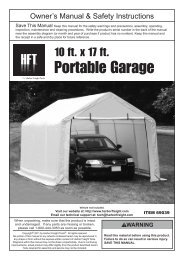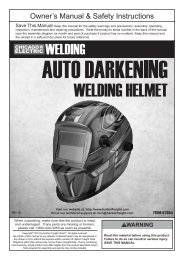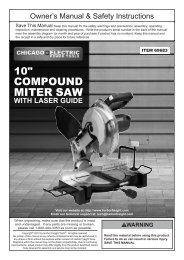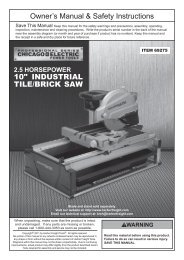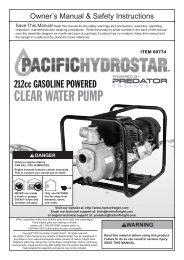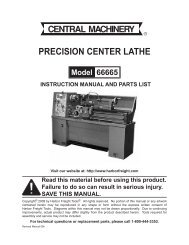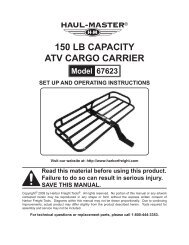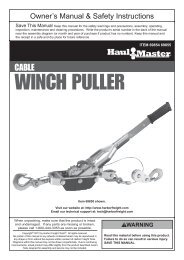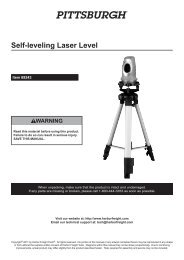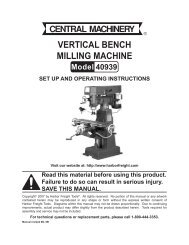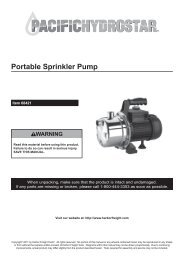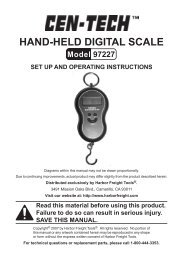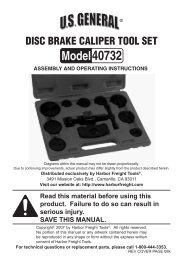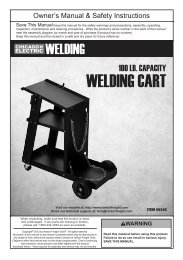90 AMP FLUX WIRE WELDER - Harbor Freight Tools
90 AMP FLUX WIRE WELDER - Harbor Freight Tools
90 AMP FLUX WIRE WELDER - Harbor Freight Tools
You also want an ePaper? Increase the reach of your titles
YUMPU automatically turns print PDFs into web optimized ePapers that Google loves.
Owner’s Manual & Safety Instructions<br />
Save This Manual Keep this manual for the safety warnings and precautions, assembly, operating,<br />
inspection, maintenance and cleaning procedures. Write the product’s serial number in the back of the manual<br />
near the assembly diagram (or month and year of purchase if product has no number). Keep this manual and<br />
the receipt in a safe and dry place for future reference.<br />
<strong>90</strong> <strong>AMP</strong><br />
<strong>FLUX</strong> <strong>WIRE</strong> <strong>WELDER</strong><br />
REV 12a<br />
Visit our website at: http://www.harborfreight.com<br />
Email our technical support at: tech@harborfreight.com<br />
ITEM 68887<br />
When unpacking, make sure that the product is intact<br />
and undamaged. If any parts are missing or broken,<br />
please call 1-800-444-3353 as soon as possible.<br />
Copyright © 2011 by <strong>Harbor</strong> <strong>Freight</strong> <strong>Tools</strong> ® . All rights reserved. No portion of<br />
this manual or any artwork contained herein may be reproduced in any shape<br />
or form without the express written consent of <strong>Harbor</strong> <strong>Freight</strong> <strong>Tools</strong>. Diagrams<br />
within this manual may not be drawn proportionally. Due to continuing<br />
improvements, actual product may differ slightly from the product described<br />
herein. <strong>Tools</strong> required for assembly and service may not be included.<br />
Read this material before using this product.<br />
Failure to do so can result in serious injury.<br />
SAVE THIS MANUAL.
Table of Contents<br />
SAFETY SETUP BASIC WELDING WELDING TIPS MAINTENANCE<br />
Safety.......................................................... 2<br />
Specifications.............................................. 7<br />
Setup........................................................... 7<br />
Basic Welding............................................. 12<br />
WARNING SYMBOLS AND DEFINITIONS<br />
Welding Tips............................................... 18<br />
Maintenance............................................... 22<br />
Parts Lists and Diagrams........................... 26<br />
Warranty..................................................... 28<br />
This is the safety alert symbol. It is used to alert you to potential personal injury hazards.<br />
Obey all safety messages that follow this symbol to avoid possible injury or death.<br />
Indicates a hazardous situation which, if not avoided,<br />
will result in death or serious injury.<br />
Indicates a hazardous situation which, if not avoided,<br />
could result in death or serious injury.<br />
Indicates a hazardous situation which, if not avoided,<br />
could result in minor or moderate injury.<br />
Addresses practices not related to personal injury.<br />
IMPORTANT SAFETY INFORMATION<br />
Read all safety warnings and instructions.<br />
Failure to follow the warnings and instructions may result in electric shock, fire and/or serious injury.<br />
Save all warnings and instructions for future reference.<br />
General Safety<br />
PROTECT yourself and others. Read and understand this information.<br />
1. Before use, read and understand<br />
manufacturer′s instructions,<br />
Material Safety Data Sheets (MSDS′s),<br />
employer′s safety practices, and ANSI Z49.1.<br />
2. Keep out of reach of children.<br />
Keep children and bystanders away while operating.<br />
3. Place the welder on a stable location before use.<br />
If it falls while plugged in, severe injury,<br />
electric shock, or fire may result.<br />
4. Do not overreach.<br />
Keep proper footing and balance at all times.<br />
5. Stay alert, watch what you are doing and use<br />
common sense when operating a welder.<br />
Do not use a welder while you are tired or under<br />
the influence of drugs, alcohol or medication.<br />
A moment of inattention while operating welders<br />
may result in serious personal injury.<br />
6. Avoid unintentional starting. Make sure you are<br />
prepared to begin work before turning on the Welder.<br />
7. Never leave the Welder unattended while<br />
energized. Turn power off if you have to leave.<br />
8. The warnings, precautions, and instructions<br />
discussed in this instruction manual cannot<br />
cover all possible conditions and situations<br />
that may occur. It must be understood by the<br />
operator that common sense and caution are<br />
factors which cannot be built into this product,<br />
but must be supplied by the operator.<br />
9. This product, when used for welding and similar<br />
applications, contains or produces a chemical<br />
known to the State of California to cause cancer<br />
and birth defects (or other reproductive harm).<br />
(California Health & Safety Code § 25249.5, et seq.)<br />
10. Handling the cord on this product will expose<br />
you to lead, a chemical known to the State of<br />
California to cause cancer, and birth defects or<br />
other reproductive harm.<br />
Wash hands after handling.<br />
(California Health & Safety Code § 25249.5, et seq.)<br />
Page 2 For technical questions, please call 1-800-444-3353. SKU 68887
Fume and Gas Safety<br />
1. Exposure to welding or cutting<br />
exhaust fumes can increase the risk<br />
of developing certain cancers, such as<br />
cancer of the larynx and lung cancer.<br />
Also, some diseases that may be linked to exposure<br />
to welding or cutting exhaust fumes are:<br />
• Early onset of Parkinson’s Disease<br />
• Heart disease • Ulcers<br />
• Damage to the reproductive organs<br />
• Inflammation of the small intestine or<br />
stomach<br />
• Kidney damage<br />
• Respiratory diseases such as<br />
emphysema, bronchitis, or pneumonia<br />
2. Do not use near degreasing or<br />
painting operations.<br />
3. Keep head out of fumes.<br />
Do not breathe exhaust fumes.<br />
Arc Ray Safety<br />
1. Wear ANSI-approved welding eye protection<br />
featuring at least a number 10 shade lens rating.<br />
2. Wear leather leggings, fire resistant shoes<br />
or boots during use. Do not wear pants with<br />
cuffs, shirts with open pockets, or any clothing<br />
that can catch and hold molten metal or sparks.<br />
3. Keep clothing free of grease, oil,<br />
solvents, or any flammable substances.<br />
Wear dry, insulating gloves and protective clothing.<br />
FUMES AND GASES can be hazardous to your health.<br />
4. Use enough ventilation, exhaust at arc, or<br />
both, to keep fumes and gases from breathing<br />
zone and general area. If engineering controls<br />
are not feasible, use an approved respirator.<br />
5. Work in a confined area only if it<br />
is well-ventilated, or while wearing<br />
an air-supplied respirator.<br />
ARC RAYS can injure eyes and burn skin.<br />
6. Have a recognized specialist in<br />
Industrial Hygiene or Environmental Services<br />
check the operation and air quality<br />
and make recommendations<br />
for the specific welding situation.<br />
Follow OSHA guidelines for<br />
Permissible Exposure Limits (PEL’s) and<br />
the American Conference of Governmental<br />
Industrial Hygienists recommendations for<br />
Threshold Limit Values (TLV’s) for fumes and gases.<br />
4. Wear an approved head covering to protect<br />
the head and neck. Use aprons, cape, sleeves,<br />
shoulder covers, and bibs designed and<br />
approved for welding and cutting procedures.<br />
5. When welding/cutting overhead or in confined<br />
spaces, wear flame resistant ear plugs or<br />
ear muffs to keep sparks out of ears.<br />
SAFETY<br />
MAINTENANCE WELDING TIPS BASIC WELDING SETUP<br />
SKU 68887<br />
For technical questions, please call 1-800-444-3353.<br />
Page 3
Electrical Safety<br />
ELECTRIC SHOCK can KILL.<br />
SAFETY SETUP BASIC WELDING WELDING TIPS MAINTENANCE<br />
1. Turn off, disconnect power, and<br />
discharge electrode to ground before setting<br />
down torch/electrode holder and before service.<br />
2. Do not touch energized electrical parts.<br />
Wear dry, insulating gloves. Do not touch electrode<br />
holder, electrode, welding torch, or welding wire with<br />
bare hand. Do not wear wet or damaged gloves.<br />
3. Connect to grounded, GFCI‐protected<br />
power supply only.<br />
4. Do not use near water or damp objects.<br />
5. People with pacemakers should consult their<br />
physician(s) before use. Electromagnetic fields<br />
in close proximity to heart pacemaker could cause<br />
pacemaker interference or pacemaker failure.<br />
Fire Safety<br />
1. Clear away or protect flammable objects.<br />
Remove or make safe all combustible materials for a<br />
radius of 35 feet (10 meters) around the work area.<br />
Use a fire resistant material to cover or block all open<br />
doorways, windows, cracks, and other openings.<br />
2. Keep ABC-type fire extinguisher near<br />
work area and know how to use it.<br />
3. Maintain a safe working environment.<br />
Keep the work area well lit.<br />
Make sure there is adequate surrounding workspace.<br />
Keep the work area free of obstructions,<br />
grease, oil, trash, and other debris.<br />
4. Do not operate welders in atmospheres<br />
containing dangerously reactive or<br />
flammable liquids, gases, vapors, or dust.<br />
Provide adequate ventilation in work areas<br />
to prevent accumulation of such substances.<br />
Welders create sparks which may ignite flammable<br />
substances or make reactive fumes toxic.<br />
6. Do not expose welders to rain or wet conditions.<br />
Water entering a welder will increase<br />
the risk of electric shock.<br />
7. Do not abuse the cord. Never use the cord<br />
for carrying, pulling or unplugging the welder.<br />
Keep cord away from heat, oil, sharp edges<br />
or moving parts. Damaged or entangled<br />
cords increase the risk of electric shock.<br />
8. Do not use outdoors.<br />
ARC AND HOT SLAG can cause fire.<br />
9. Insulate yourself from the workpiece and ground.<br />
Use nonflammable, dry insulating material if possible,<br />
or use dry rubber mats, dry wood or plywood, or<br />
other dry insulating material large enough to cover<br />
your full area of contact with the work or ground.<br />
10. Use care not to touch the welding tip to<br />
grounded material whenever the unit is<br />
plugged in. Electric shock, fire, or burns may<br />
happen if appropriate precautions are not taken.<br />
5. If working on a metal wall, ceiling, etc.,<br />
prevent ignition of combustibles on the<br />
other side by moving the combustibles to a<br />
safe location. If relocation of combustibles is<br />
not possible, designate someone to serve as<br />
a fire watch, equipped with a fire extinguisher,<br />
during the cutting process and for at least one<br />
half hour after the cutting is completed.<br />
6. Do not weld or cut on materials having<br />
a combustible coating or combustible<br />
internal structure, as in walls or ceilings, without<br />
an approved method for eliminating the hazard.<br />
7. Do not dispose of hot slag in containers<br />
holding combustible materials.<br />
8. After welding, make a thorough examination<br />
for evidence of fire. Be aware that easily<br />
visible smoke or flame may not be present<br />
for some time after the fire has started.<br />
9. Do not apply heat to a container that has held<br />
an unknown substance or a combustible<br />
material whose contents, when heated,<br />
can produce flammable or explosive vapors.<br />
Clean and purge containers before applying heat.<br />
Vent closed containers, including castings,<br />
before preheating, welding, or cutting.<br />
Page 4 For technical questions, please call 1-800-444-3353. SKU 68887
Welder use and care<br />
1. Do not use the welder if the switch does not turn<br />
it on and off. Any welder that cannot be controlled<br />
with the switch is dangerous and must be repaired.<br />
2. Disconnect the plug from the power<br />
source before making any adjustments,<br />
changing accessories, or storing welders.<br />
Such preventive safety measures reduce the<br />
risk of starting the welder accidentally.<br />
3. Prevent unintentional starting.<br />
Ensure the switch is in the off-position before<br />
connecting to power source or moving<br />
the welder. Carrying or energizing welders<br />
that have the switch on invites accidents.<br />
Maintenance<br />
1. Maintain welders. Check for misalignment or<br />
binding of moving parts, breakage of parts<br />
and any other condition that may affect the<br />
welder’s operation. If damaged, have the<br />
welder repaired before use. Many accidents<br />
are caused by poorly maintained welders.<br />
2. Have your welder serviced by a qualified<br />
repair person using only identical<br />
replacement parts. This will ensure that<br />
the safety of the welder is maintained.<br />
4. Store idle welders out of the reach of children and<br />
do not allow persons unfamiliar with the welder or<br />
these instructions to operate the welder. Welders<br />
are dangerous in the hands of untrained users.<br />
5. Use the welder and accessories in accordance<br />
with these instructions, taking into account the<br />
working conditions and the work to be performed.<br />
Use of the welder for operations different from those<br />
intended could result in a hazardous situation.<br />
3. Maintain labels and nameplates on the Welder.<br />
These carry important information.<br />
If unreadable or missing, contact<br />
<strong>Harbor</strong> <strong>Freight</strong> <strong>Tools</strong> for a replacement.<br />
4. Unplug before maintenance. Unplug the Welder<br />
from its electrical outlet before any inspection,<br />
maintenance, or cleaning procedures.<br />
SAVE THESE INSTRUCTIONS.<br />
SAFETY<br />
MAINTENANCE WELDING TIPS BASIC WELDING SETUP<br />
SKU 68887<br />
For technical questions, please call 1-800-444-3353.<br />
Page 5
Grounding<br />
SAFETY SETUP BASIC WELDING WELDING TIPS MAINTENANCE<br />
TO PREVENT ELECTRIC SHOCK AND DEATH FROM INCORRECT GROUNDING <strong>WIRE</strong><br />
CONNECTION:<br />
Check with a qualified electrician if you are in doubt as to whether the outlet is properly grounded.<br />
Have a plug installed by a certified electrician. Do not use the Welder if the power cord or plug is<br />
damaged. If damaged, have it repaired by a service facility before use. If the plug will not fit the<br />
outlet, have a proper outlet installed by a qualified electrician.<br />
Grounded Welders<br />
1. The grounding prong in the plug is connected<br />
through the green wire inside the cord to the<br />
grounding system in the Welder. The green wire<br />
in the cord must be the only wire connected to<br />
the Welder’s grounding system and must never<br />
be attached to an electrically “live” terminal.<br />
Extension Cords<br />
1. If an extension cord is used, it must have<br />
the following wire size: up to 30 feet, use<br />
10 AWG size wire; 30 to 50 feet, use 8 AWG<br />
wire; Over 50 feet, use 6 AWG wire.<br />
2. As the distance from the supply outlet increases,<br />
you must use a heavier gauge extension cord.<br />
Using extension cords with inadequately sized<br />
wire causes a serious drop in voltage, resulting<br />
in loss of power and possible welder damage.<br />
3. The smaller the gauge number of the wire,<br />
the greater the capacity of the cord. For<br />
example, a 14 gauge cord can carry a<br />
higher current than a 16 gauge cord.<br />
Symbology<br />
Wire Feed (Speed)<br />
Workpiece Ground Cable<br />
Gun Cable<br />
Overheat Shutdown Indicator<br />
Cooling Fan<br />
Housing Ground Point<br />
2. The Welder must be plugged into an appropriate<br />
outlet, properly installed and grounded in<br />
accordance with all codes and ordinances.<br />
4. When using more than one extension cord to<br />
make up the total length, make sure each cord<br />
contains at least the minimum wire size required.<br />
5. If you are using one extension cord for more than<br />
one welder, add the nameplate amperes and use the<br />
sum to determine the required minimum cord size.<br />
6. If you are using an extension cord outdoors, make<br />
sure it is marked with the suffix “W-A” (“W” in<br />
Canada) to indicate it is acceptable for outdoor use.<br />
7. Make sure the extension cord is properly wired<br />
and in good electrical condition. Always replace<br />
a damaged extension cord or have it repaired<br />
by a qualified electrician before using it.<br />
8. Protect the extension cords from sharp objects,<br />
excessive heat, and damp or wet areas.<br />
V~<br />
A<br />
OCV<br />
KVA<br />
IPM<br />
AWG<br />
Volts Alternating Current<br />
Amperes<br />
Open Circuit Voltage<br />
Kilovolt Amperes<br />
(Volts / 1000 * Amperes)<br />
Inches Per Minute<br />
American Wire Gauge<br />
Page 6 For technical questions, please call 1-800-444-3353. SKU 68887
Specifications<br />
Electrical Rating<br />
120V~ / 20A<br />
Welding Output<br />
60 ~ 120 A, AC<br />
Capacity<br />
18 gauge (0.048″) to 3/16″ (0.19″) mild steel only<br />
Not for welding aluminum or stainless steel<br />
Duty Cycle<br />
20% @ <strong>90</strong>A<br />
(See explanation on page 14)<br />
Open Circuit Voltage 27<br />
KVA 2.38<br />
Welder Tips / Wire Size Installed tip will accept .030″ to .035″ <strong>FLUX</strong> CORE wire<br />
Wire Spool Capacity 4″ diameter / 2 lb. spool<br />
Setup<br />
Read the ENTIRE IMPORTANT SAFETY INFORMATION section at the beginning of this<br />
manual including all text under subheadings therein before set up or use of this product.<br />
Cover Assembly<br />
1. Slide the Handle into the slot on<br />
the Cover from the back.<br />
TO PREVENT SERIOUS INJURY FROM ACCIDENTAL OPERATION:<br />
Turn the Power Switch off and unplug the welder before assembly.<br />
2. The notch on the front of the Handle should drop<br />
into the slot in the Cover. Both ends of the Handle<br />
should lay flush against the top of the Cover.<br />
3. Secure with Screw at front of unit.<br />
notch drops<br />
into slot on<br />
Cover here<br />
Handle<br />
Cover<br />
Screw<br />
SAFETY<br />
MAINTENANCE WELDING TIPS BASIC WELDING SETUP<br />
SKU 68887<br />
For technical questions, please call 1-800-444-3353.<br />
Page 7
Wire Spool Installation<br />
GUN<br />
<strong>90</strong> <strong>AMP</strong> <strong>FLUX</strong> <strong>WIRE</strong> <strong>WELDER</strong><br />
ITEM 68887<br />
SAFETY SETUP BASIC WELDING WELDING TIPS MAINTENANCE<br />
1. Turn the Welder to OFF and unplug<br />
it before proceeding.<br />
2. Press in the pin at the top center of<br />
the control panel and open the cover.<br />
3. Remove the Knob, Spring and the Top Plate.<br />
If replacing a Spool, remove the old Spool<br />
and all remaining wire from the liners.<br />
4. Place the new flux core Wire Spool<br />
over the Spool Spindle.<br />
To prevent wire feed problems, set the Spool<br />
so that it will unwind counterclockwise .<br />
5. Replace the Top Plate (turned as shown in<br />
illustration), the Spring and the Knob.<br />
GROUND<br />
<strong>WIRE</strong> FEED SPEED<br />
ON<br />
OFF<br />
120V~<br />
60Hz<br />
20A<br />
MIN<br />
MAX<br />
Wire .030″-.035″ Flux-core<br />
Capacity XX Ga. – X/X″ Steel Plate<br />
Electrode – X′<br />
Cables<br />
Ground Clamp – X′<br />
Cover<br />
.030″<br />
wire must<br />
unwind this<br />
direction<br />
Wire<br />
Spool<br />
Knob<br />
Spring<br />
Top Plate<br />
Wire Spool<br />
Spindle<br />
Page 8 For technical questions, please call 1-800-444-3353. SKU 68887
6. Turn the Feed Tensioner counterclockwise to<br />
loosen it enough to pull it up, releasing tension.<br />
Swing the Feed Swing Arm out. (Note: Do<br />
not loosen the Feed Tensioner too<br />
much, or it will come apart.)<br />
.030″<br />
.030″<br />
7. Loosen and remove the Feed Knob. Compare<br />
the wire diameter marked on the Wire Spool with<br />
the stamped number on the top of the Feed Roller.<br />
The Roller’s groove size must be compatible with<br />
the wire diameter -<br />
.8mm rollers also work with .030″ wire &<br />
.9mm rollers also work with .035″ wire.<br />
Flip the Feed Roller as needed and confirm that the<br />
number facing up is the same as the wire diameter<br />
on the Spool.<br />
Replace and secure the Feed Knob.<br />
IMPORTANT:<br />
Securely hold onto the end of the welding wire and<br />
keep tension on it during the following steps.<br />
If this is not done, the welding wire will unravel<br />
and create a tangled “bird’s nest”, wasting wire.<br />
8. Cut off all bent and crimped wire.<br />
Make sure that the cut end has no burrs<br />
or sharp edges; cut again if needed.<br />
9. Keep tension on the wire and guide at least<br />
12 inches of wire into the Wire Liners.<br />
10. Swing the Feed Swing Arm closed, and swing<br />
the Feed Tensioner across the tip of the Arm, to<br />
latch it. Make sure the Welding Wire is resting in<br />
the top groove of the Feed Roller, then turn the<br />
Feed Tensioner clockwise a couple of turns.<br />
After the wire is held by the Feed<br />
Tensioner, you may release it.<br />
11. Pull the Nozzle to remove it.<br />
12. Using the third oval hole on the Multi-wrench, turn<br />
the Contact Tip counterclockwise and remove.<br />
13. Lay the Gun Cable out in a straight line so that the<br />
wire moves through it easily. Leave the cover open,<br />
so that the feed mechanism can be observed.<br />
Feed Swing<br />
Arm<br />
Wire<br />
Liner<br />
.030″<br />
Feed<br />
Knob<br />
.030″<br />
Feed Swing<br />
Arm<br />
Nozzle<br />
Contact<br />
Tip<br />
Feed<br />
Tensioner<br />
leader<br />
wire liner<br />
Feed<br />
Roller<br />
.030″<br />
HOLD <strong>WIRE</strong><br />
SECURELY<br />
Feed<br />
Tensioner<br />
welding<br />
wire<br />
Wire<br />
Spool<br />
.030″<br />
Gun<br />
SAFETY<br />
MAINTENANCE WELDING TIPS BASIC WELDING SETUP<br />
SKU 68887<br />
For technical questions, please call 1-800-444-3353.<br />
Page 9
SAFETY SETUP BASIC WELDING WELDING TIPS MAINTENANCE<br />
14. Do not touch the Gun’s Trigger.<br />
Plug the Power Cord into its electrical<br />
outlet and turn the welder to ON.<br />
15. Point the Gun away from all objects and press the<br />
Trigger until the wire feeds out of the gun two inches.<br />
The Wire Liner may come out with the welding<br />
wire, this is normal, just push the Wire Liner<br />
back into the Gun.<br />
If the wire does not feed properly and the<br />
Spool is stationary, turn the welder to OFF,<br />
unplug it, and slightly tighten the Feed<br />
Tensioner clockwise before retrying.<br />
WARNING<br />
The following steps require applying power to the welder<br />
with the cover open.<br />
To prevent serious injury from fire or electric shock:<br />
1. Do not touch anything, especially not the Ground Clamp,<br />
with the Gun or welding wire or an arc will be ignited.<br />
2. Do not touch internal welder components<br />
while it is plugged in.<br />
Welding<br />
Wire<br />
2″<br />
GUN<br />
GROUND<br />
<strong>90</strong> <strong>AMP</strong> <strong>FLUX</strong> <strong>WIRE</strong> <strong>WELDER</strong><br />
<strong>WIRE</strong> FEED SPEED<br />
ITEM 68887<br />
ON<br />
OFF<br />
120V~<br />
60Hz<br />
20A<br />
MIN<br />
MAX<br />
Wire .030″-.035″ Flux-core<br />
Capacity XX Ga. – X/X″ Steel Plate<br />
Electrode – X′<br />
Cables<br />
Ground Clamp – X′<br />
Gun<br />
Page 10 For technical questions, please call 1-800-444-3353. SKU 68887
16. To check the wire’s drive tension, feed the wire<br />
against a piece of wood from 2 to 3 inches away. If<br />
the wire stops instead of bending, turn the welder to<br />
OFF, unplug it, slightly tighten the Feed Tensioner<br />
clockwise , and try again.<br />
If the wire bends from the feed tension,<br />
then the tension is set properly.<br />
.030″<br />
Incrementally<br />
increase tension<br />
until<br />
wire bends.<br />
2-3″<br />
SAFETY<br />
17. TURN THE <strong>WELDER</strong> TO OFF.<br />
18. Select a Contact Tip that is compatible with the<br />
welding wire used. The included Tip (.035″) will work<br />
with both .030″ and .035″ wire. Slide the Contact<br />
Tip over the wire and thread it clockwise into the<br />
Gun. Tighten the Contact Tip using a wrench.<br />
19. Replace the Nozzle and cut the wire<br />
off at 1 / 2 ″ from tip ( 1 / 2 ″ stickout).<br />
20. Swing the Cover closed until the<br />
Cover Latch locks in place.<br />
GUN<br />
Nozzle<br />
GROUND<br />
<strong>90</strong> <strong>AMP</strong> <strong>FLUX</strong> <strong>WIRE</strong> <strong>WELDER</strong><br />
<strong>WIRE</strong> FEED SPEED<br />
Contact<br />
Tip<br />
ITEM 68887<br />
ON<br />
OFF<br />
120V~<br />
60Hz<br />
20A<br />
MIN<br />
MAX<br />
Wire .030″-.035″ Flux-core<br />
Capacity XX Ga. – X/X″ Steel Plate<br />
Electrode – X′<br />
Cables<br />
Ground Clamp – X′<br />
Gun<br />
MAINTENANCE WELDING TIPS BASIC WELDING SETUP<br />
SKU 68887<br />
For technical questions, please call 1-800-444-3353.<br />
Page 11
Basic Welding<br />
SAFETY SETUP BASIC WELDING WELDING TIPS MAINTENANCE<br />
Read the ENTIRE IMPORTANT SAFETY INFORMATION section at the beginning of<br />
this manual including all text under subheadings therein before welding.<br />
TO PREVENT SERIOUS INJURY:<br />
Protective gear must be worn when using the<br />
Welder; minimum shade number 10 full face shield<br />
(or welding mask), ear protection, welding gloves,<br />
sleeves and apron, NIOSH-approved respirator, and<br />
fire resistant work clothes without pockets should be<br />
worn when welding.<br />
Light from the arc can cause permanent damage to<br />
the eyes and skin.<br />
Do not breathe arc fumes.<br />
TO PREVENT SERIOUS INJURY,<br />
FIRE AND BURNS:<br />
Keep welding tip clear of grounded<br />
objects whenever unit is plugged in.<br />
<strong>WIRE</strong> FEED SPEED<br />
The Flux Wire Welder is used to weld sheet metal<br />
and low carbon steel. Good welding takes a degree<br />
of skill and experience. Practice a few sample<br />
welds on scrap before welding your first project.<br />
Additional practice periods are recommended whenever<br />
you weld a different thickness of material or weld a<br />
different type of connection.<br />
Make practice welds on pieces of scrap to practice<br />
technique before welding anything of value.<br />
GUN<br />
GROUND<br />
<strong>90</strong> <strong>AMP</strong> <strong>FLUX</strong> <strong>WIRE</strong> <strong>WELDER</strong><br />
ITEM 68887<br />
ON<br />
OFF<br />
120V~<br />
60Hz<br />
20A<br />
MIN<br />
MAX<br />
Wire .030″-.035″ Flux-core<br />
Capacity XX Ga. – X/X″ Steel Plate<br />
Electrode – X′<br />
Cables<br />
Ground Clamp – X′<br />
=<br />
Practice your welding<br />
technique on scrap<br />
pieces before welding<br />
anything of value.<br />
Page 12 For technical questions, please call 1-800-444-3353. SKU 68887
Control Panel Layout<br />
Gun<br />
Cable<br />
GUN<br />
SAFETY<br />
<strong>90</strong> <strong>AMP</strong> <strong>FLUX</strong> <strong>WIRE</strong> <strong>WELDER</strong><br />
ITEM 68887<br />
Overload<br />
Indicator<br />
Wire<br />
Speed<br />
Dial<br />
Ground<br />
Cable<br />
GROUND<br />
<strong>WIRE</strong> FEED SPEED<br />
Gun Cable:<br />
The welding Gun connects here. The wire and welding<br />
current feeds to the weld through here.<br />
The welding Gun is energized whenever<br />
the Power Switch is on.<br />
Wire Speed Dial:<br />
This controls the speed that the welding wire feeds out of<br />
the welding Gun.<br />
Adjust this according to the weld settings chart<br />
to achieve a good weld. (See next page.)<br />
Ground Cable:<br />
This connects to the base metal to provide a good<br />
connection for the current to travel back to the welder.<br />
ON<br />
OFF<br />
120V~<br />
60Hz<br />
20A<br />
MIN<br />
MAX<br />
Wire .030″-.035″ Flux-core<br />
Capacity XX Ga. – X/X″ Steel Plate<br />
Electrode – X′<br />
Cables<br />
Ground Clamp – X′<br />
Current<br />
Switch<br />
Power<br />
Switch<br />
Power<br />
Cord<br />
Overload Indicator:<br />
This lights up if duty cycle work period is exceeded<br />
and the welder is overheated. Rest the Gun on an<br />
electrically non-conductive, heat-resistant surface, such<br />
as a concrete slab, well clear of the ground clamp while<br />
allowing the welder to cool with the Power Switch on, so<br />
the Fan can help cool the welder. Once the welder cools<br />
enough to be used again, use shorter welding periods<br />
and longer rest periods to prevent needless wear.<br />
Current Switch:<br />
This controls the output amperage of the welder.<br />
Adjust this according to the weld settings<br />
chart to achieve a good weld.<br />
Power Switch:<br />
This turns on power to the Welding Gun<br />
and internal cooling fan.<br />
Power Cord:<br />
Plug the Power Cord into a properly grounded<br />
120 V~ outlet, on at least a 20 amp dedicated circuit<br />
with delayed action type circuit breaker or fuses.<br />
MAINTENANCE WELDING TIPS BASIC WELDING SETUP<br />
SKU 68887<br />
For technical questions, please call 1-800-444-3353.<br />
Page 13
Weld Settings Chart<br />
SAFETY SETUP BASIC WELDING WELDING TIPS MAINTENANCE<br />
NOTE: The numbers within the<br />
spaces are the approximate wire<br />
feed settings recommended* for this<br />
wire size and material thickness.<br />
.030″ Wire Size<br />
(Flux Core, Mild Steel)<br />
.035″ Wire Size<br />
(Flux Core, Mild Steel)<br />
Material Thickness (Steel)<br />
18 Gauge 16 Gauge 14 Gauge 1 / 8 ″ 3 / 16 ″<br />
1.5<br />
speed<br />
1.5<br />
speed<br />
MIN current<br />
2<br />
speed<br />
2<br />
speed<br />
4<br />
speed<br />
3<br />
speed<br />
MAX current<br />
8<br />
speed<br />
8<br />
speed<br />
* This chart is only intended to show general guidelines for different wire sizes and for different<br />
thicknesses of material. The settings should only be used at the beginning of a weld and must be<br />
adjusted after stopping and carefully inspecting the weld. Proper welding takes experience.<br />
Duty Cycle (Duration of Use)<br />
Avoid damage to the Welder by not welding<br />
for more than the prescribed duty cycle time.<br />
The Duty Cycle defines the number of minutes, within<br />
a 10 minute period, during which a given welder can<br />
produce a particular welding current without overheating.<br />
For example, this Welder with a 20% duty cycle at<br />
rated output (<strong>90</strong>A) must be allowed to rest for at<br />
least 8 minutes after every 2 minutes of continuous weld.<br />
Failure to carefully observe duty cycle limitations<br />
can easily over‐stress a welder’s power generation<br />
system contributing to premature welder failure. GUN<br />
This welder has an internal thermal protection<br />
<strong>90</strong> <strong>AMP</strong> <strong>FLUX</strong> <strong>WIRE</strong> <strong>WELDER</strong><br />
ITEM 68887<br />
system to help prevent this sort of over-stress.<br />
When the unit overheats, it automatically shuts down and<br />
the Overload Indicator lights. The welder automatically<br />
ON<br />
returns to service after cooling off. Rest the Gun on<br />
an electrically non-conductive, heat‐proof surface,<br />
such as a concrete slab, well clear of the ground clamp<br />
OFF<br />
while allowing the welder to cool with the Power Switch<br />
<strong>WIRE</strong> FEED SPEED Wire<br />
on, so that the internal Fan will help cool the welder.<br />
Electrode – X′<br />
Cables<br />
When the welder can be used again, use shorter welding<br />
periods and longer rest periods to prevent needless GROUND wear.<br />
20% Rated Duty Cycle<br />
at <strong>90</strong>A output<br />
2 minutes welding<br />
followed by<br />
at least 8 minutes of rest<br />
120V~<br />
60Hz<br />
20A<br />
MIN<br />
MAX<br />
.030″-.035″ Flux-core<br />
Capacity XX Ga. – X/X″ Steel Plate<br />
Ground Clamp – X′<br />
Gun<br />
9<br />
speed<br />
9.5<br />
speed<br />
concrete slab<br />
(or other heat-proof,<br />
non-conductive<br />
surface)<br />
Page 14 For technical questions, please call 1-800-444-3353. SKU 68887
Setting Up The Weld<br />
1. Make practice welds on pieces of scrap the same<br />
thickness as your intended workpiece to practice<br />
technique before welding anything of value.<br />
Clean the weld surfaces thoroughly with<br />
a wire brush or angle grinder; there must<br />
be no rust, paint, oil, or other materials on<br />
the weld surfaces, only bare metal.<br />
2. Use clamps (not included) to hold the workpieces<br />
in position so that you can concentrate on<br />
proper welding technique. The distance<br />
(if any) between the two workpieces must be<br />
controlled properly to allow the weld to hold<br />
both sides securely while allowing the weld<br />
to penetrate fully into the joint. The edges of<br />
thicker workpieces may need to be chamfered<br />
(or beveled) to allow proper weld penetration.<br />
3. Clamp Ground Cable to bare metal on the<br />
workpiece near the weld area, or to metal work<br />
bench where the workpiece is clamped.<br />
4. Set the Wire Speed Dial and<br />
the Current Switch to the desired settings.<br />
Refer to the chart on the welder<br />
or the chart on the facing page.<br />
WARNING! DO NOT SWITCH THE<br />
CURRENT WHILE WELDING.<br />
5. Flip the Power Switch to the OFF position, then plug<br />
the Welder into a dedicated, 120 V~, 20 A circuit<br />
with delayed action type circuit breaker or fuses.<br />
6. Hold the Gun, without touching the Trigger, with the<br />
wire and tip clearly away from any grounded objects.<br />
Then, turn the Power Switch to ON.<br />
GUN<br />
GROUND<br />
GUN<br />
GUN<br />
GROUND<br />
GROUND<br />
<strong>90</strong> <strong>AMP</strong> <strong>FLUX</strong> <strong>WIRE</strong> <strong>WELDER</strong><br />
<strong>WIRE</strong> FEED SPEED<br />
ITEM 68887<br />
<strong>WIRE</strong> FEED SPEED<br />
<strong>90</strong> <strong>AMP</strong> <strong>FLUX</strong> <strong>WIRE</strong> <strong>WELDER</strong><br />
<strong>WIRE</strong> FEED SPEED<br />
ITEM 68887<br />
ON<br />
OFF<br />
120V~<br />
60Hz<br />
20A<br />
clamps<br />
workpieces<br />
Clean<br />
surfaces to<br />
bare metal.<br />
Chamfer thick workpieces.<br />
MIN<br />
MAX<br />
Wire .030″-.035″ Flux-core<br />
Capacity XX Ga. – X/X″ Steel Plate<br />
Electrode – X′<br />
Cables<br />
Ground Clamp – X′<br />
<strong>90</strong> <strong>AMP</strong> <strong>FLUX</strong> <strong>WIRE</strong> <strong>WELDER</strong><br />
ON<br />
OFF<br />
ITEM 68887<br />
GUN<br />
ON MIN<br />
OFF MAX<br />
Wire .030″-.035″ Flux-core <strong>WIRE</strong> FEED SPEED<br />
Capacity XX Ga. – X/X″ Steel Plate<br />
Electrode – X′<br />
Cables<br />
Ground Clamp – X′+<br />
MIN<br />
MAX<br />
Wire .030″-.035″ Flux-core<br />
Capacity XX Ga. – X/X″ Steel Plate<br />
Electrode – X′<br />
Cables<br />
Ground Clamp – X′<br />
120V~<br />
60Hz<br />
20A<br />
HOLD<br />
GUN<br />
CLEAR<br />
GROUND<br />
120V~<br />
60Hz<br />
20A<br />
Ground<br />
Clamp<br />
<strong>90</strong> <strong>AMP</strong> <strong>FLUX</strong> <strong>WIRE</strong> <strong>WELDER</strong><br />
GUN<br />
ITEM 68887<br />
ON<br />
OFF<br />
120V~<br />
60Hz<br />
20A<br />
Workpiece<br />
Clean<br />
surface to<br />
bare metal.<br />
MIN<br />
MAX<br />
Wire .030″-.035″ Flux-core<br />
Capacity XX Ga. – X/X″ Steel Plate<br />
Electrode – X′<br />
Cables<br />
Ground Clamp – X′<br />
20 Amp minimum circuit<br />
<strong>90</strong> <strong>AMP</strong> <strong>FLUX</strong> <strong>WIRE</strong> <strong>WELDER</strong><br />
<strong>WIRE</strong> FEED SPEED<br />
ITEM 68887<br />
ON<br />
OFF<br />
MIN<br />
MAX<br />
Wire .030″-.035″ Flux-core<br />
Capacity XX Ga. – X/X″ Steel Plate<br />
Electrode – X′<br />
Cables<br />
Ground Clamp – X′<br />
SAFETY<br />
MAINTENANCE WELDING TIPS BASIC WELDING SETUP<br />
SKU 68887<br />
For technical questions, please call 1-800-444-3353.<br />
GROUND<br />
120V~<br />
60Hz<br />
20A<br />
Page 15
Basic Welding Technique<br />
SAFETY SETUP BASIC WELDING WELDING TIPS MAINTENANCE<br />
1. Press (and hold) Trigger and contact area to<br />
be welded with electrode wire to ignite arc.<br />
2. For a narrow weld, you can usually draw the wire in<br />
a steady straight line,<br />
this is called a stringer bead.<br />
For a wider weld, draw the wire back and forth<br />
across the joint, this is called a weave bead.<br />
3. Hold Gun in one hand and the face shield in the<br />
other. If a hands-free welding shield (not included,<br />
see Arc Ray Safety on page 3 for guidelines) is<br />
used, then both hands can be used to control Gun.<br />
4. Direct the welding wire straight into the joint.<br />
This gives an angle of <strong>90</strong>° (straight up and<br />
down) for butt (end to end) welds, and an<br />
angle of 45° for fillet (T-shaped) welds.<br />
5. The end of Gun should be tilted so that wire<br />
is angled anywhere in‐between straight on<br />
and 15° in the direction you are welding. The<br />
amount of tilt is called the drag angle.<br />
6. The welding wire should extend no more than 1 / 2 ″<br />
past the tip.<br />
This distance is called stickout or CTWD<br />
- Contact Tip to Work Distance.<br />
stringer bead<br />
Weld Gun angles,<br />
viewed from front of weld joint.<br />
45°<br />
fillet weld joint<br />
Drag Angle<br />
0-15°<br />
Weld<br />
Direction<br />
Stickout<br />
(up to 1 / 2 ″)<br />
weave bead<br />
<strong>90</strong>°<br />
butt weld joint<br />
Page 16 For technical questions, please call 1-800-444-3353. SKU 68887
GUN<br />
Note: If Welder is used too long, the amber Overload<br />
Indicator will light and the Welder Gun will shut off<br />
until the welder cools. If this happens, rest the Gun on<br />
an electrically non-conductive, heat-resistant surface,<br />
such as a concrete slab, well clear of the ground<br />
clamp. Wait about 8-10 minutes with the Power<br />
Switch to ON for the welder to cool. When the welder<br />
can be used again, use shorter welding periods and<br />
longer rest periods to help prevent needless wear.<br />
<strong>90</strong> <strong>AMP</strong> <strong>FLUX</strong> <strong>WIRE</strong> <strong>WELDER</strong><br />
<strong>WIRE</strong> FEED SPEED<br />
ITEM 68887<br />
ON<br />
OFF<br />
MIN<br />
MAX<br />
Wire .030″-.035″ Flux-core<br />
Capacity XX Ga. – X/X″ Steel Plate<br />
Electrode – X′<br />
Cables<br />
Ground Clamp – X′<br />
Gun<br />
concrete slab<br />
(or other heat-proof,<br />
non-conductive<br />
surface)<br />
SAFETY<br />
GROUND<br />
120V~<br />
60Hz<br />
20A<br />
7. After welding the test weld on a piece of scrap for a<br />
few seconds, stop, and check your progress. Clean,<br />
then compare your weld’s appearance with the diagrams<br />
and descriptions in the Welding Tips section starting on<br />
the next page. After making any necessary adjustments,<br />
continue to weld while carefully following the<br />
DUTY CYCLE guidelines as explained on page 14.<br />
8. When the weld is complete,<br />
lift the Gun and welding wire clearly away from any<br />
grounded object, and turn the Power Switch off.<br />
9. Set the Gun down on a heat‐proof, electrically<br />
non‐conductive surface. Unplug the Power Cord.<br />
After practice welding for a few<br />
seconds, STOP and examine<br />
your weld using the guidelines<br />
starting on the next page.<br />
HOLD<br />
GUN<br />
CLEAR<br />
Gun<br />
FOLLOW DUTY CYCLE!<br />
concrete slab<br />
(or other heat-proof,<br />
non-conductive<br />
surface)<br />
up to 2 minutes welding<br />
at rated output<br />
GUN<br />
GROUND<br />
<strong>90</strong> <strong>AMP</strong> <strong>FLUX</strong> <strong>WIRE</strong> <strong>WELDER</strong><br />
<strong>WIRE</strong> FEED SPEED<br />
ITEM 68887<br />
ON<br />
OFF<br />
120V~<br />
60Hz<br />
20A<br />
MIN<br />
MAX<br />
Wire .030″-.035″ Flux-core<br />
Capacity XX Ga. – X/X″ Steel Plate<br />
Electrode – X′<br />
Cables<br />
Ground Clamp – X′<br />
MAINTENANCE WELDING TIPS BASIC WELDING SETUP<br />
SKU 68887<br />
For technical questions, please call 1-800-444-3353.<br />
Page 17
Welding Tips<br />
SAFETY SETUP BASIC WELDING WELDING TIPS MAINTENANCE<br />
A good way to test welding technique is to<br />
examine a weld’s appearance after it has<br />
cooled and the slag has been removed.<br />
Then, better welding can be learned by adjusting your<br />
weld technique to remedy any problems found.<br />
Cleaning the Weld<br />
TO PREVENT SERIOUS INJURY:<br />
Continue to wear ANSI-approved safety<br />
goggles and protective wear when<br />
cleaning a weld.<br />
Sparks or chips may fly when cleaning.<br />
1. A weld from flux core wire will be covered by slag:<br />
use a Chipping Hammer to knock this off.<br />
Be careful not to damage the<br />
weld or base material.<br />
2. Then, use a Wire Brush to further<br />
clean the weld or use an angle grinder<br />
(sold separately) to shape the weld.<br />
Strike Test<br />
A test weld on a PIECE OF SCRAP can be<br />
tested by using the following procedure.<br />
WEAR ANSI-APPROVED SAFETY GOGGLES<br />
DURING THIS PROCEDURE.<br />
WARNING! This test WILL damage the weld it is<br />
performed on. This test is ONLY an indicator of weld<br />
technique and is not intended to test working welds.<br />
1. After two scraps have been welded together and the<br />
weld has cooled, clamp one scrap in a sturdy vise.<br />
2. Stay clear from underneath while you strike<br />
the opposite scrap with a heavy hammer,<br />
preferably a dead-blow hammer.<br />
3. A GOOD WELD will deform but not break,<br />
as shown on top.<br />
A POOR WELD will be brittle and snap<br />
at the weld, as shown on bottom.<br />
A typical Flux-core Wire (FCAW) Weld<br />
before cleaning.<br />
weld bead<br />
slag<br />
spatter<br />
dead-blow hammer<br />
dead-blow hammer<br />
base metal<br />
SCRAP<br />
workpiece<br />
clamp<br />
GOOD WELD<br />
bends and is not brittle<br />
SCRAP<br />
workpiece<br />
POOR WELD<br />
snaps or cracks<br />
clamp<br />
Page 18 For technical questions, please call 1-800-444-3353. SKU 68887
Weld Diagnosis<br />
Workpiece Heat Control / Weld Penetration<br />
INADEQUATE PENETRATION<br />
PROPER PENETRATION<br />
EXCESS PENETRATION OR<br />
BURN-THROUGH<br />
SAFETY<br />
Not hot enough<br />
Ideal heat<br />
Too hot<br />
SKU 68887<br />
How to increase workpiece heat<br />
and increase penetration:<br />
(to weld THICKER workpieces properly)<br />
a. Use MAX setting<br />
b. Weld more slowly<br />
Example Weld Diagrams<br />
Good<br />
Weld<br />
GUN<br />
GROUND<br />
<strong>90</strong> <strong>AMP</strong> <strong>FLUX</strong> <strong>WIRE</strong> <strong>WELDER</strong><br />
<strong>WIRE</strong> FEED SPEED<br />
ITEM 68887<br />
Current<br />
Too Low<br />
TO CORRECT:<br />
ON<br />
OFF<br />
120V~<br />
60Hz<br />
20A<br />
GUN<br />
MIN<br />
MAX<br />
GROUND<br />
Wire .030″-.035″ Flux-core<br />
Capacity XX Ga. – X/X″ Steel Plate<br />
Electrode – X′<br />
Cables<br />
Ground Clamp – X′<br />
c. Use faster wire feed<br />
d. Use shorter stickout<br />
<strong>90</strong> <strong>AMP</strong> <strong>FLUX</strong> <strong>WIRE</strong> <strong>WELDER</strong><br />
<strong>WIRE</strong> FEED SPEED<br />
ITEM 68887<br />
TO CORRECT:<br />
ON<br />
GUN<br />
OFF<br />
Current<br />
Too High or<br />
Wire Feed<br />
Too Fast<br />
MIN<br />
MAX<br />
Wire .030″-.035″ Flux-core<br />
Capacity XX Ga. – X/X″ Steel Plate<br />
Electrode – X′<br />
Cables<br />
Ground Clamp – X′<br />
<strong>90</strong> <strong>AMP</strong> <strong>FLUX</strong> <strong>WIRE</strong> <strong>WELDER</strong><br />
120V~<br />
60Hz<br />
20A<br />
or<br />
<strong>WIRE</strong> FEED SPEED<br />
ITEM 68887<br />
ON<br />
OFF<br />
For technical GROUND questions, please call 1-800-444-3353.<br />
120V~<br />
60Hz<br />
20A<br />
How to reduce workpiece heat<br />
and limit penetration:<br />
(to weld THINNER workpieces properly)<br />
a. Use MIN setting<br />
b. Weld more quickly<br />
Weld Speed<br />
Too Fast<br />
TO CORRECT:<br />
MIN<br />
MAX<br />
Wire .030″-.035″ Flux-core<br />
Capacity XX Ga. – X/X″ Steel Plate<br />
Electrode – X′<br />
Cables<br />
Ground Clamp – X′<br />
weld<br />
slower<br />
c. Use slower wire feed<br />
d. Use longer stickout<br />
Weld Speed<br />
Too Slow<br />
TO CORRECT:<br />
weld<br />
faster<br />
Stickout<br />
Too Long<br />
TO CORRECT:<br />
maintain<br />
less<br />
than 1 / 2 ″<br />
stickout<br />
Page 19<br />
MAINTENANCE WELDING TIPS BASIC WELDING SETUP
Weld Problems<br />
Penetration (Workpiece Heat Control)<br />
SAFETY SETUP BASIC WELDING WELDING TIPS MAINTENANCE<br />
EXCESS PENETRATION OR<br />
BURN-THROUGH<br />
Weld droops on top and<br />
underneath or falls through<br />
entirely, making a hole.<br />
Weld Not Adhering Properly<br />
Gaps present between weld and previous bead or<br />
between weld and workpiece. See areas below.<br />
PROFILE<br />
VIEW<br />
POSSIBLE CAUSES AND SOLUTIONS<br />
1. Workpiece overheating:<br />
Reduce wire feed speed.<br />
Use MIN setting.<br />
2. Welding speed too slow:<br />
Increase welding speed and ensure<br />
that welding speed is kept steady.<br />
3. Excessive material at weld:<br />
Reduce wire feed speed.<br />
POSSIBLE CAUSES AND SOLUTIONS<br />
1. Incorrect welding technique:<br />
Place stringer bead at correct place in joint.<br />
Adjust workpiece position or weld angle to permit<br />
proper welding to bottom of piece.<br />
Pause briefly at sides during weave bead.<br />
Keep arc on leading edge of weld puddle.<br />
Hold gun at proper angles.<br />
2. Insufficient weld heat:<br />
Increase current and/or wire feed speed.<br />
3. Dirty workpiece:<br />
Clean workpiece down to bare metal.<br />
4. Insufficient weld material:<br />
Increase wire feed speed.<br />
PROPER PENETRATION<br />
Weld is visible underneath and<br />
bulges slightly on top.<br />
PROFILE VIEWS<br />
Bend at Joint<br />
PROFILE<br />
VIEW<br />
POSSIBLE CAUSES AND SOLUTIONS<br />
1. Incorrect welding technique:<br />
Maintain 1 / 2 ″ or less stickout.<br />
Keep arc on leading edge of weld puddle.<br />
Hold gun at proper angles.<br />
2. Insufficient weld heat:<br />
Reduce welding speed.<br />
Use MAX setting.<br />
3. Workpieces too thick/close:<br />
Bevel thick workpieces, allow slight<br />
gap, and weld in several passes.<br />
4. Insufficient weld material:<br />
Increase wire feed speed.<br />
INADEQUATE PENETRATION<br />
Weld does not contact the joint<br />
fully, just on the surface.<br />
POSSIBLE CAUSES AND SOLUTIONS<br />
1. Improper clamping:<br />
Clamp workpieces securely.<br />
Make tack welds to hold workpieces.<br />
2. Excessive heat:<br />
Weld a small portion and allow to cool before<br />
proceeding.<br />
Increase weld speed.<br />
Reduce wire feed speed.<br />
Page 20 For technical questions, please call 1-800-444-3353. SKU 68887
Coat of Slag Over Weld<br />
TOP<br />
VIEW<br />
PARTIALLY CHIPPED AWAY TO SHOW WELD<br />
Slag is a necessary part of a fluxcore<br />
wire weld. It shields the weld from<br />
impurities. Clean off the slag with the Chipping<br />
Hammer and Wire Brush after welding.<br />
Porosity<br />
TOP<br />
VIEW<br />
Small cavities or holes in the bead.<br />
POSSIBLE CAUSES AND SOLUTIONS<br />
1. Dirty workpiece or welding wire:<br />
Clean workpiece down to bare metal.<br />
Make certain that wire is clean and free<br />
from oil, coatings, and other residues.<br />
2. Inconsistent welding speed:<br />
Maintain steady weld speed.<br />
3. Stickout too long:<br />
Reduce stickout.<br />
Crooked/Wavy Bead<br />
TOP<br />
VIEW<br />
POSSIBLE CAUSES AND SOLUTIONS<br />
1. Inaccurate welding:<br />
Use two hands or rest hand on steady surface.<br />
2. Inconsistent welding speed:<br />
Maintain steady weld speed.<br />
3. Stickout too long:<br />
Reduce stickout.<br />
Excessive Spatter<br />
Fine spatter is normal.<br />
Spatter that is grainy and large is a problem.<br />
TOP<br />
VIEW<br />
Burn-Through<br />
TOP<br />
VIEW<br />
POSSIBLE CAUSES AND SOLUTIONS<br />
1. Dirty workpiece or welding wire:<br />
Clean workpiece down to bare metal.<br />
Make certain that wire is clean and free<br />
from oil, coatings, and other residues.<br />
2. Wire feeding too fast:<br />
Reduce wire feed speed.<br />
3. Stickout too long:<br />
Reduce stickout.<br />
Base material melts away,<br />
leaving a hole in the weld.<br />
POSSIBLE CAUSES AND SOLUTIONS<br />
1. Workpiece overheating:<br />
Reduce current and/or wire feed speed.<br />
2. Welding speed too slow:<br />
Increase welding speed and ensure<br />
that welding speed is kept steady.<br />
3. Excessive material at weld:<br />
Reduce wire feed speed.<br />
SAFETY<br />
MAINTENANCE WELDING TIPS BASIC WELDING SETUP<br />
SKU 68887<br />
For technical questions, please call 1-800-444-3353.<br />
Page 21
Maintenance<br />
SAFETY SETUP BASIC WELDING WELDING TIPS MAINTENANCE<br />
TO PREVENT SERIOUS INJURY,<br />
FIRE AND BURNS:<br />
Unplug the Welder,<br />
rest the Gun on a heat-proof,<br />
electrically non-conductive surface,<br />
and allow all parts of the Welder to cool thoroughly<br />
before service.<br />
1. Periodically remove the Right and Left<br />
side panels, and using compressed air,<br />
blow out all dust from the interior.<br />
2. Store in a clean and dry location.<br />
3. For optimal weld quality, clean and<br />
inspect the Contact Tip and Nozzle<br />
before each use. See below.<br />
Nozzle Inspection, Cleaning, and Replacement<br />
1. Make sure that the entire Gun is completely<br />
cool and that the Power Cord is unplugged<br />
from the electrical outlet before proceeding.<br />
2. Turn the Nozzle counterclockwise <br />
while pulling to remove.<br />
3. Scrub the interior of the Nozzle<br />
clean with a wire brush.<br />
4. Examine the end of the Nozzle. The end should be<br />
flat and even. If the end is uneven, chipped, melted,<br />
cracked, or otherwise damaged, the Nozzle will<br />
adversely affect the weld and should be replaced.<br />
5. Reinstall the Nozzle after inspecting<br />
and cleaning the Contact Tip.<br />
Nozzle<br />
Contact<br />
Tip<br />
+<br />
Gun<br />
concrete slab<br />
(or other heat-proof,<br />
non-conductive<br />
surface)<br />
Gun<br />
Page 22 For technical questions, please call 1-800-444-3353. SKU 68887
Contact Tip Inspection,<br />
Cleaning, and Replacement<br />
1. Make sure that the entire Gun is completely<br />
cool and that the Power Cord is unplugged<br />
from the electrical outlet before proceeding.<br />
2. Remove the Nozzle as explained in the previous<br />
subheading. Using the third oval hole on the Multiwrench,<br />
turn the Contact Tip counterclockwise <br />
and slide it off the welding wire.<br />
Gun<br />
SAFETY<br />
3. Scrub the exterior of the Tip clean with a wire brush.<br />
Clean out the inside of the tip with a tip cleaner (sold<br />
separately). Check that the Tip is the proper type for<br />
the wire size used (.035″ tip for .030–.035″ wire).<br />
4. Examine the shape of the hole at the end of<br />
the Contact Tip. It should be an even circle; it<br />
should not be oblong or have any bulges in it.<br />
5. If any problems are noted, Contact Tip replacement<br />
would be advisable. Make sure to select a<br />
new Tip that is the correct size for the welding<br />
wire used (.035″ tip for .030–.035″ wire).<br />
6. Reinstall the Tip and securely<br />
reinstall the Nozzle as well.<br />
Nozzle<br />
Contact<br />
Tip<br />
MAINTENANCE WELDING TIPS BASIC WELDING SETUP<br />
SKU 68887<br />
For technical questions, please call 1-800-444-3353.<br />
Page 23
Troubleshooting<br />
SAFETY SETUP BASIC WELDING WELDING TIPS MAINTENANCE<br />
IMPORTANT!<br />
Be CERTAIN to shut off the Welder, disconnect it from power, and discharge the Gun to ground<br />
before adjusting, cleaning, or repairing the unit.<br />
Wire Feed Motor Runs But Wire Does Not Feed Properly<br />
POSSIBLE CAUSES AND SOLUTIONS<br />
1. Insufficient wire feed tension:<br />
Increase wire feed tension properly - follow number 16 on page 11.<br />
2. Incorrect wire feed roll size:<br />
Replace with the proper wire feed roll - follow the Wire Spool Installation instructions, starting on page 8.<br />
Flip over wire feed roll if necessary.<br />
3. Damaged Gun, cable, or liner assembly:<br />
Have a qualified technician inspect these parts and replace as necessary.<br />
Wire Creates A Bird’s Nest During Operation<br />
POSSIBLE CAUSES AND SOLUTIONS<br />
1. Excess wire feed tension:<br />
Adjust wire feed tension properly - follow number 16 on page 11.<br />
2. Incorrect contact tip size:<br />
Replace with the proper tip for the wire.<br />
3. Gun end not inserted into drive housing properly:<br />
Loosen gun securing bolt and push gun end into housing just enough<br />
so that it does not touch wire feed mechanism.<br />
4. Damaged liner:<br />
Have a qualified technician inspect and repair/replace as necessary.<br />
Wire Feeds, But Arc Does Not Ignite<br />
POSSIBLE CAUSES AND SOLUTIONS<br />
1. Improper ground connection:<br />
Make certain that the workpiece is contacted properly by the Ground Clamp and that the<br />
workpiece is properly cleaned near the ground clamp and the welding location.<br />
2. Improperly sized or excessively worn Contact Tip:<br />
Verify that Contact Tip is the proper size for the wire. Check that the hole in the tip<br />
is not deformed or enlarged. Also, check that the tip is not dirty; this would prevent a<br />
good connection. If needed, replace Contact Tip with proper size and type.<br />
Page 24 For technical questions, please call 1-800-444-3353. SKU 68887
TROUBLESHOOTING (continued)<br />
IMPORTANT!<br />
Be CERTAIN to shut off the Welder, disconnect it from power, and discharge the Gun to ground<br />
before adjusting, cleaning, or repairing the unit.<br />
Power Switch Lights,<br />
But Welder Does Not Function When Switched On<br />
POSSIBLE CAUSES AND SOLUTIONS<br />
1. Tripped thermal protection device:<br />
Shut the welder’s switch to off and allow it to cool for at least 20 minutes.<br />
Reduce duration or frequency of welding periods to help reduce wear on the welder.<br />
Refer to Duty Cycle section on page 14.<br />
2. Faulty or improperly connected Trigger:<br />
Qualified technician must check and secure/replace Trigger.<br />
Power Switch Does Not Light When Switched On<br />
POSSIBLE CAUSES AND SOLUTIONS<br />
Unit is not connected to outlet properly or outlet is unpowered:<br />
Verify the voltage at the outlet and the connection to the outlet.<br />
If voltage is not present at outlet, check circuit breaker/GFCI devices; if any are tripped,<br />
determine and remedy cause before resetting. Verify that the circuit is designed to<br />
supply the required input amperage as detailed on the Specifications table.<br />
Weak Arc Strength<br />
Welding Arc Not Stable<br />
POSSIBLE CAUSES AND SOLUTIONS<br />
1. Wire not feeding properly:<br />
See first Troubleshooting section - Wire feed motor runs but wire does not feed properly.<br />
2. Incorrect contact tip size:<br />
Replace with the proper tip for .030″ wire.<br />
3. Incorrect wire feed speed:<br />
Adjust wire feed speed to achieve a more stable arc.<br />
4. Loose Gun cable or ground cable:<br />
Check to ensure that all connections are tight.<br />
POSSIBLE CAUSES AND SOLUTIONS<br />
1. Incorrect line voltage:<br />
Check the line voltage and, if insufficient, have a licensed electrician remedy the situation.<br />
2. Improper gauge or length of extension cord:<br />
Extension cords are not recommended. If possible, eliminate the use of an extension cord.<br />
If an extension cord is needed, refer to the guidelines on page 6.<br />
5. Damaged Gun or loose connection within Gun:<br />
Have a qualified technician inspect and repair/replace as necessary.<br />
6. Adjust current setting:<br />
Make sure setting matches recommended setting on chart.<br />
SAFETY<br />
MAINTENANCE WELDING TIPS BASIC WELDING SETUP<br />
SKU 68887<br />
For technical questions, please call 1-800-444-3353.<br />
Page 25
Parts Lists and Diagrams<br />
Wiring Schematic<br />
SAFETY SETUP BASIC WELDING WELDING TIPS MAINTENANCE<br />
Parts List<br />
S1<br />
1 2 3 4<br />
24V<br />
1 2 3<br />
S2<br />
MAX<br />
MIN<br />
J<br />
1 Grounding Cable 1<br />
2 MIG Torch 1<br />
3 Potentiometer Knob 1<br />
4 Indicator 1<br />
5 MIG Torch Holder 1<br />
6 Font Panel 1<br />
7 Left Panel 1<br />
8 Middle Panel 1<br />
9 Wire Feeder 1<br />
10 Pin Latch 1<br />
11 Latch Bracket 1<br />
12 Top Cover 1<br />
13 Handle 1<br />
14 Transformer 1<br />
R<br />
A<br />
B<br />
C<br />
1<br />
2 3 4<br />
T1<br />
G<br />
15 Heat Relay 1<br />
16 Fan 1<br />
17 Fan Motor 1<br />
18 Bottom 1<br />
19 Right Panel 1<br />
20 Spool Holder 1<br />
21 Fan Bracket 4<br />
22 Control Transformer 1<br />
23 PCB 1<br />
24 PCB Holder 1<br />
25 Cable Holder 2<br />
26 Setting Switch 1<br />
27 Power Cord 1<br />
28 Switch 1<br />
Q<br />
b<br />
Page 26 For technical questions, please call 1-800-444-3353. SKU 68887<br />
REV 12a
Assembly Diagram<br />
SAFETY<br />
Part 9 Detail<br />
9f (hidden by part 9e)<br />
9e<br />
.030″<br />
9c<br />
9b<br />
Record Product’s Serial Number Here:<br />
Note: If product has no serial number, record month and year of purchase instead.<br />
Note: Some parts are listed and shown for illustration purposes only, and<br />
are not available individually as replacement parts.<br />
REV 12a<br />
9a<br />
9d<br />
MAINTENANCE WELDING TIPS BASIC WELDING SETUP<br />
SKU 68887<br />
For technical questions, please call 1-800-444-3353.<br />
Page 27
Limited <strong>90</strong> Day Warranty<br />
<strong>Harbor</strong> <strong>Freight</strong> <strong>Tools</strong> Co. makes every effort to assure that its products meet high quality and durability standards,<br />
and warrants to the original purchaser that this product is free from defects in materials and workmanship for the<br />
period of <strong>90</strong> days from the date of purchase. This warranty does not apply to damage due directly or indirectly,<br />
to misuse, abuse, negligence or accidents, repairs or alterations outside our facilities, criminal activity, improper<br />
installation, normal wear and tear, or to lack of maintenance. We shall in no event be liable for death, injuries<br />
to persons or property, or for incidental, contingent, special or consequential damages arising from the use of<br />
our product. Some states do not allow the exclusion or limitation of incidental or consequential damages, so the<br />
above limitation of exclusion may not apply to you. THIS WARRANTY IS EXPRESSLY IN LIEU OF ALL OTHER<br />
WARRANTIES, EXPRESS OR IMPLIED, INCLUDING THE WARRANTIES OF MERCHANTABILITY AND FITNESS.<br />
To take advantage of this warranty, the product or part must be returned to us with transportation charges<br />
prepaid. Proof of purchase date and an explanation of the complaint must accompany the merchandise.<br />
If our inspection verifies the defect, we will either repair or replace the product at our election or we may<br />
elect to refund the purchase price if we cannot readily and quickly provide you with a replacement. We will<br />
return repaired products at our expense, but if we determine there is no defect, or that the defect resulted<br />
from causes not within the scope of our warranty, then you must bear the cost of returning the product.<br />
This warranty gives you specific legal rights and you may also have other rights which vary from state to state.<br />
PLEASE READ THE FOLLOWING CAREFULLY<br />
THE MANUFACTURER AND/OR DISTRIBUTOR HAS PROVIDED THE PARTS DIAGRAM IN THIS MANUAL<br />
AS A REFERENCE TOOL ONLY. NEITHER THE MANUFACTURER NOR DISTRIBUTOR MAKES ANY<br />
REPRESENTATION OR WARRANTY OF ANY KIND TO THE BUYER THAT HE OR SHE IS QUALIFIED TO<br />
MAKE ANY REPAIRS TO THE PRODUCT OR THAT HE OR SHE IS QUALIFIED TO REPLACE ANY PARTS<br />
OF THE PRODUCT. IN FACT, THE MANUFACTURER AND/OR DISTRIBUTOR EXPRESSLY STATES<br />
THAT ALL REPAIRS AND PARTS REPLACEMENTS SHOULD BE UNDERTAKEN BY CERTIFIED AND<br />
LICENSED TECHNICIANS AND NOT BY THE BUYER. THE BUYER ASSUMES ALL RISK AND LIABILITY<br />
ARISING OUT OF HIS OR HER REPAIRS TO THE ORIGINAL PRODUCT OR REPLACEMENT PARTS<br />
THERETO, OR ARISING OUT OF HIS OR HER INSTALLATION OF REPLACEMENT PARTS THERETO.<br />
3491 Mission Oaks Blvd. • PO Box 6009 • Camarillo, CA 93011 • (800) 444-3353



